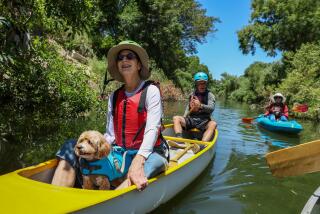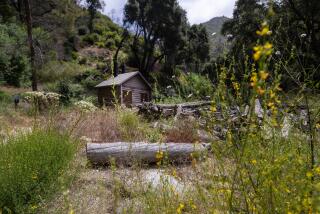Joggers Running the Risk at Closed Trail in Sepulveda Recreation Area
- Share via
ENCINO — Gasping for air, they hop the city fences or crawl through wire-cut entrances, ignoring signs that warn them of the danger ahead.
Inside, some huff their way along the slippery dirt and concrete banks of the Los Angeles River with only their sneaker treads keeping them from plunging into the water.
Others have sunk through the thin top crust of mud beds, sometimes up to their waists. They have been trapped, as if in quicksand, in their quest to be fit.
These are the die-hard runners and walkers who frequent the Sepulveda Dam Recreation Area.
They are not thrill-seekers. They are just tired of waiting.
More than half a year has passed since a barrage of El Nino storms ravaged the city recreation area surrounding the federally operated Sepulveda Flood Control Basin, prompting federal officials to declare the area a disaster site.
While most of the network of parks, trails and fields near Burbank Boulevard and Woodley Avenue have since been reopened by the city, nearly half of the 3.5-mile dirt path surrounding the flood basin has been closed since February.
Fenced off, the trail--a favorite nature escape for hundreds of Valley fitness buffs--is filled with caked mud and debris. There’s no sign of repair work being done.
It is uncertain how long the track will be off-limits, due to a dispute over repair costs between the Los Angeles Recreation and Parks Department and the Federal Emergency Management Agency.
Frustrated with the months of government bureaucracy that is depriving them of one of the last open spaces in the Valley, several runners and hikers have found ways to get onto the trail. Whether climbing the fences or cutting new entrances in them, they defiantly flout city warnings that the area is hazardous. They also risk fines if caught inside.
Tony Amersfoort didn’t care about that risk, recently hopping over a locked gate that kept him from the dirt trail he prefers. A concrete bike path was never closed by the flooding, but that’s not the choice of runners.
“I’m not going to run on concrete,” he said. “It’s bad for your knees.”
The situation angers Carol Tucker, a frequent jogger from Van Nuys.
“I’m so mad,” she said. “They’ve had this place closed for months.”
A discrepancy exists between FEMA and the city over what it will take to return the dirt trail and part of the connecting bike path to pre-flood conditions. Where parks officials see the job costing roughly $200,000, FEMA figures it should cost no more than $44,000, said Anthony Gonzalez, a city finance officer.
Flood repairs are nothing new to the recreation area.
Since 1992, the city has used more than $2.6 million in federal assistance for flood-related damages to the Sepulveda Dam Recreation Area.
So far this year, the city recreation and parks department has spent $300,000 in city funds to fix some flood-damaged golf courses and playing fields. But the department has held off on repairing the dirt trail while it appeals the disaster-relief application denied by FEMA.
The FEMA officials considering the appeal were attending a weeklong seminar and could not be reached for comment.
James Ward, who oversees the maintenance of city parks in the Valley, said department workers will likely begin making minor repairs to the track during the next few weeks. But the major work will have to wait until the dispute is settled, he said.
“We’ve been going round and round with” FEMA and cost figures, Ward said. “Their ideas about the cleanup are not exactly the same as what we are required to do” by the Army Corps of Engineers, which leases the park land to the city.
When the basin was designed in the early 1940s, its second use as a recreational site did not face a high likelihood of flooding. But as the Valley developed, runoff into the Los Angeles River increased during storms, making the basin’s trails and parks more prone to floods.
As a hedge against flood damage today, Ward said, the city is required by the corps to keep the flood capacity in the recreation area at a constant level. That means carting additional mud and silt from the trails when the adjacent Los Angeles River floods, he said.
FEMA based its cost estimate of the current repairs on the assumption that the dirt and mud can merely be shoved aside, Ward said.
Faced with what corps officials say is increased flooding in the Sepulveda Dam Recreation Area during heavy rains, Ward is frustrated by the continual funding headache over repairs.
“They just don’t give us realistic funding,” Ward said of FEMA. “I think the federal government is starting to [cut back] its support of communities” with perennial disaster-related expenses.
Though FEMA officials deny lowering financial aid priorities to any areas facing disasters, Ward is partially correct.
FEMA spokeswoman Val Bunting said the agency is wary of becoming a permanent funding source for areas like the Sepulveda Basin.
“We can’t continue to deliver the same amount of disaster assistance to the same areas as we have in the past,” she said. “People in those areas have to take responsibility for being prepared for the next disaster.”
To help communities mitigate the impact of continual floods and other natural disasters, FEMA will soon launch a nationwide educational program called Project Impact, Bunting said.
Through the program, FEMA will attempt to rally local governments and other community members to design more effective disaster-preparedness plans, while contributing more money toward that goal, she said.
“With issues like repetitive floods, we will be encouraging local communities to look at how they can prevent further damages in the future,” she said.
Cindy Bahr of Encino said plans to guard against future damages are all fine and well but she wants her favorite trail back now.
“It is perfectly runnable the way it is,” the 32-year-old jogger said. “This is ridiculous. The only danger there is is from the fact that the fences are closed and people have to climb over them.”
Times staff writer Boris Yaro and Times correspondent Edward Yoon contributed to this story.
More to Read
Sign up for The Wild
We’ll help you find the best places to hike, bike and run, as well as the perfect silent spots for meditation and yoga.
You may occasionally receive promotional content from the Los Angeles Times.






